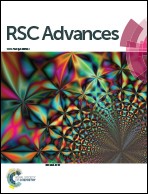Effect of the graphene oxide reduction method on the photocatalytic and electrocatalytic activities of reduced graphene oxide/TiO2 composite†
Abstract
Graphene oxide (GO) was synthesized from commercial graphite using a modified Hummers' method. Three different methods were used to prepare reduced GO/TiO2 composites. GO was (i) initially impregnated over TiO2 (GOTi) and then reduced using a stream of hydrogen gas at 450 °C (H2RGOTi), (ii) reduced using hydrazine hydrate solution (HH) in a 1000 W microwave oven (HHRGO) and then loaded on the TiO2 (HHRGOTi) or (iii) hydrothermally reduced (RGO) then loaded on TiO2 (RGOTi). Different characterization techniques were used e.g. X-ray photoelectron spectroscopy (XPS), X-ray diffraction patterns (XRD) and UV-Vis, Fourier transform infrared (FT-IR) and Raman spectroscopy. The effect of the GO reduction method on the photocatalytic activity of the aforementioned composites towards the degradation of phenol in the presence and absence of (i) UV and (ii) H2O2 was examined. High phenol degradation rates were achieved using the RGOTi photocatalyst, compared to the TiO2 nanoparticles, under UV illumination. On the other hand, the H2RGOTi composite has shown the highest electrocatalytic activity towards the oxygen reduction reaction under UV illumination.


 Please wait while we load your content...
Please wait while we load your content...